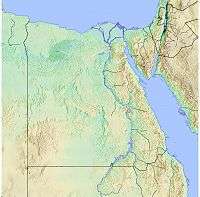Al-Askar
al-‘Askar (Arabic: العسكر) was the capital of Egypt from 750-868, when Egypt was a province of the Abbasid Caliphate.
History

After the Muslim conquest of Egypt in 641, Rashidun commander Amr ibn al-As established Fustat just north of Coptic Cairo. At Caliph Umar's request, the Egyptian capital was moved from Alexandria to the new city on the eastern side of the Nile.
The reach of the Umayyads was extensive, stretching from western Spain all the way to eastern China. However, they were overthrown by the Abbasids, who moved the capital of the Umayyad empire itself to Baghdad. In Egypt, this shift in power involved moving control from the Umayyad city of al-Fustat slightly north to the Abbasid city of al-‘Askar. Its full name was مدينة العسكري Madinatu l-‘Askari "City of Cantonments" or "City of Sections".[1] Intended primarily as a city large enough to house an army, it was laid out in a grid pattern that could be easily subdivided into separate sections for various groups such as merchants and officers.
The peak of the Abbasid dynasty occurred during the reign of Harun al Rashid, along with increased taxes on the Egyptians, who rose up in a peasant revolt in 832 during the time of Caliph al-Ma'mun. Local Egyptian governors gained increasing autonomy, and in 870, governor Ahmad ibn Tulun declared Egypt's independence (though still nominally under the rule of the Abbasid Caliph). As a symbol of this independence, in 868 ibn Tulun founded yet another capital, al-Qatta'i, slightly further north of al-‘Askar. The capital remained there until 905, until the city was destroyed, and the administrative capital of Egypt then returned to al-Fusṭāṭ.[2]
Al-Fusṭāṭ itself was destroyed by a vizier-ordered fire that burned from 1168 to 1169, at which time the capital moved to nearly al-Qāhirah (Cairo), where it has remained to this day. Cairo's bounds grew to eventually encompass the three earlier capitals of al-Fusṭāṭ, al-Qatta'i and al-‘Askar, the remnants of which can today be seen in "Old Cairo" in the southern part of the city.
References
- ↑ "Al-Qatta'i". menic.utexas.edu. Retrieved 2009-08-15.
- ↑ "Cairo History: The City of Tents". web.archive.org. Archived from the original on 2007-08-24. Retrieved 2009-08-15.
External links
| Preceded by Fustat |
Capital of Egypt 750-868 |
Succeeded by Al-Qatta'i |
Coordinates: 30°01′26″N 31°14′52″E / 30.02389°N 31.24778°E